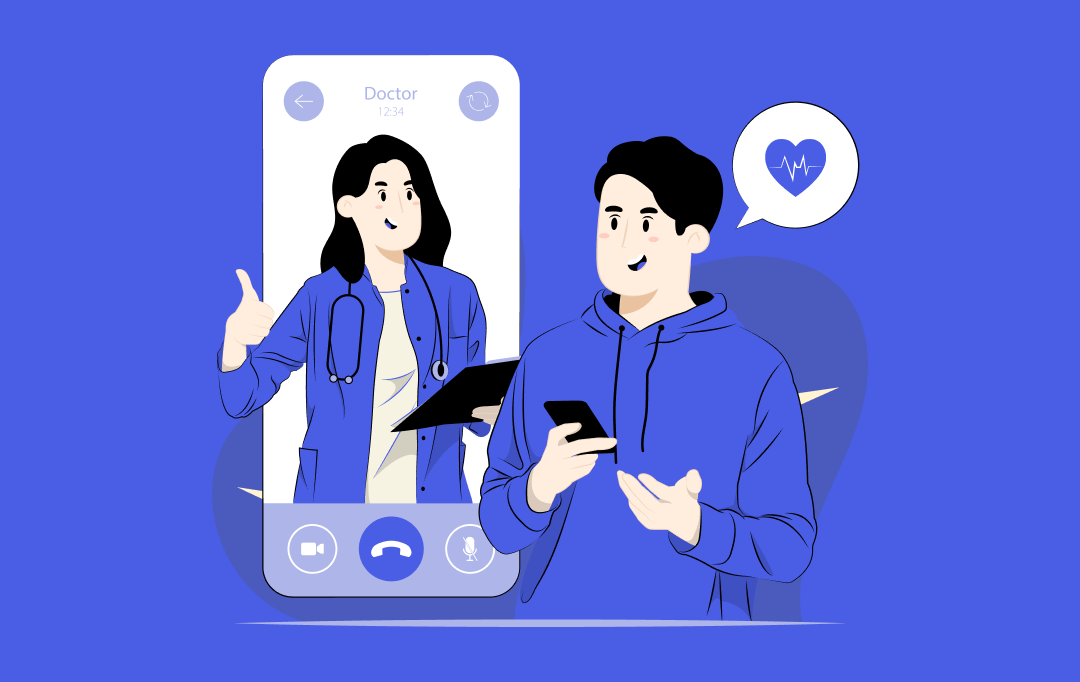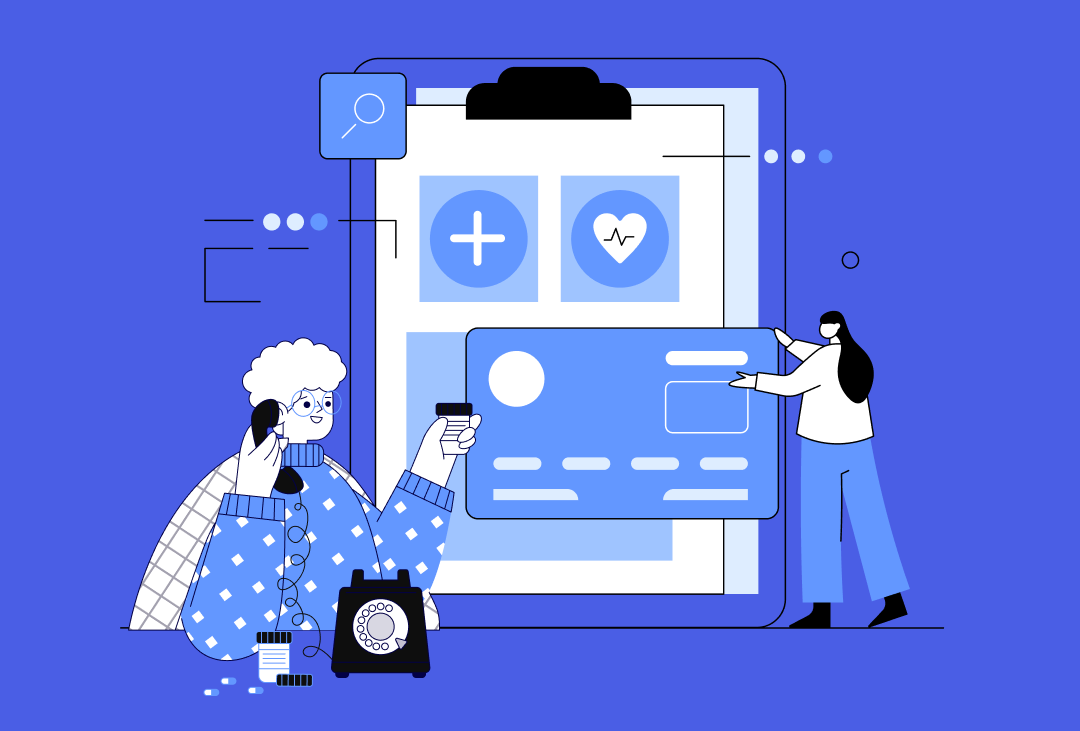- Current Challenges of Electronic Health Records
- Physician Burnout
- Interoperability
- Top Technology Innovations Supporting Electronic Health Records
- 1. EHR Optimization to Increase Usability
- 2. Amplification of Interoperability Through Artificial Intelligence
- 3. Virtual Assistants to Help with Documentation
- 4. Combining EHR With Voice Recognition
- 5. Making More Informed Care Decisions with Predictive Analysis
- 6. Preparing Extensively for the 5G Network
- 7. Moving to the Mobile and Cloud
- The Future of EHR
- FAQs
EHR systems have already come a long way in the industry. However, they can be improved for better patient care and information availability.
Electronic Health Record (EHR) is an electronically stored collection of patient-related information. Progress in the proliferation of screening tests, medical imaging, and diagnostics has produced a plethora of data on patient health.
There are ways to share information across numerous healthcare networks, for instance, providing the ability to offer a greater level of healthcare based on the ease of information availability and collection to medical professionals.
The estimated global market size for electronic health records was $29.06 billion in 2024, with a projected CAGR of 4.1% from 2025 to 2030. The market is witnessing steady growth, driven by advancements in healthcare technology and the increasing digitization of medical records or adoption and integration of EMR worldwide.

Electronic health record systems are a perfect solution for better patient care. These days as more patient data is getting digital and an increasing number of consumers are aspiring to have mobile access to health records, which points towards the technology impact on EHR. The EHR improvements have led to better patient outcomes in 2025, paving a great future of electronic health records.
In this blog, we will talk about how to improve EHR system, the EHR implementation challenges over the years, and how technology on EHR can help streamline healthcare operations.
With the facts and statistics stated above, it’s evident that EHRs are expected to improve even more in 2025 for both providers and patients. But there are still some limitations that are being faced in the current situation. Let’s discuss the challenges of electronic health records next.
Current Challenges of Electronic Health Records
Utilizing mobile app solutions, the healthcare sector has enhanced its patient-centered strategy and is keeping patients’ health while delivering a positive user experience. With healthcare software development, it has become easier for patients to get access to quick medical care.
With the healthcare sector moving towards technology in a fast-pace, the industry also needs to be aware of the risks associated with it. History is a witness to incidents where these types of technologies became prone to hackers because of being exposed to the internet without any security mechanism. Despite all the potential benefits that it provides, physicians still have a hard time adopting EHRs. Let’s check out some of the challenges associated with EHR implementation in healthcare centers.

Physician Burnout
The most prevalent issue in the current healthcare sector is physical burnout. An estimated 50-60% of physicians have experienced burnout that resulted in lower patient satisfaction, reduced patient safety, and higher malpractice claims.
EHRs contribute to the burnout of physicians because of their hard-to-understand user interface. There’s a significant amount of time required to feed the data in EHR systems. Due to this, physicians don’t get enough time to work on communication with patients.
As a result, the quality of patient care is decreased and physicians also experience more stress and lower job satisfaction. Moreover, in multiple instances, EHRs are also said to be a financial burden on both providers and practitioners.
Also Read- EMR Vs EHR Development – What Should you Choose for your Healthcare Business?
Interoperability
Interoperability is described as the capability of EHR software to provide data and information to other devices so that multiple users can make use of it.
There are a number of issues standing in front of the complete adoption of interoperability in the healthcare sector –

The issues ripple down to the EHR systems as well where challenges implementing electronic health records become a big problem because of a lack of interoperability between disparate systems. To get a complete picture of a patient’s medical history, it is imperative for the systems to communicate efficiently with each other.
Communication of data in an EHR often gets delayed because of insufficient interoperability inside segments of a similar EHR or from the EHR to a different system. There can be cases such as where clinicians couldn’t get to labs for an emergency or a hospital patient from records held in a different part of the hospital.
It remains an immense test for healthcare app development company providers to build an interoperable framework that enables the exchange of data among multiple providers.
Top Technology Innovations Supporting Electronic Health Records

Numerous healthcare systems have started paying closer attention to technological developments, such as data standards, artificial intelligence in healthcare, and predictive analytics, in order to create EHR processes that are both more effective and to return the systems to their original purpose: improving patient care.
In addition to having a significant effect on society as a whole, technology development is also having an impact on the medical industry and, more specifically, electronic health records (EHRs).
But because technology is advancing so quickly, older tools must be updated and modified to stay up.
1. EHR Optimization to Increase Usability
The EHR’s user interface will be the factor that has the greatest influence on optimization.
Patient safety, clinic operations, and burnout are all significantly impacted by how providers use the tool in their daily work. This is due to interface navigation.
A poorly designed or optimized EHR product will have a cluttered user UI or a complicated medication list. For reducing duplicate order input, an EHR-based reminder could be a helpful substitute for intrusive post-order alerts.
2. Amplification of Interoperability Through Artificial Intelligence
EHRs have brought about a number of issues, such as obstructing clinician processes, restricting interoperability, and producing an abundance of data. But EHR vendors are attempting to enhance their products in light of the adoption of cutting-edge technology like AI for enhancing better medical diagnosis.
Despite the advent of digital health records, doctors continue to struggle with the interoperability of health data. It’s challenging for providers to use the EHR to enhance patient care because the majority of technology suppliers don’t make it simple to share patient information.
However, very few of these respondents claimed to be using cutting-edge tools like blockchain in healthcare, and application programming interfaces (APIs) to boost interoperability.
3. Virtual Assistants to Help with Documentation
The way doctors record their time with patients is being targeted by new technologies. Clinicians frequently experience brain load as a result of hopping from patient to patient. When providers must play catch-up on documentation at the close of the day, they run into difficulties. Implementing a well-designed EHR scribe tool into the EHR workflow is one method to address this problem.
Hop on to the article, How to build an EHR system? Features and cost breakdown, to know how you can build one successfully for your business.
4. Combining EHR With Voice Recognition
Voice recognition technology is a great asset for EHR systems as it helps clinicians to enter information and patient data hands-free. It reduces inaccuracy and errors by dictating records in EHR, which further speeds up the information recording process.
There’s a track record of Artificial Intelligence transforming the healthcare sector by helping doctors in recognizing historical trends about the condition of a patient and making diagnoses. That’s why several companies are trying to incorporate AI into EHR with the help of voice recognition technology.
For instance, a physician would be able to ask the EHR system about the last recorded iron levels from a blood test of a patient by using voice-enabled technology. After giving the commands, the system will notify the doctors about the health status of the patient.
5. Making More Informed Care Decisions with Predictive Analysis
The healthcare industry is also influenced highly by predictive analytics applications. From impacting cancer treatments to optimizing emergency staffing, predictive analytics technology is being used in a wide range of applications and will soon be adopted even more.
Specific healthcare app development services use AI-powered analytic methods such as statistics, data mining, and modeling in compliance with AI to provide clinical outcome predictions based on real-time device data and EHR to enhance the patient experience and care delivery.
6. Preparing Extensively for the 5G Network
It’s a no-brainer that the 5G network will capture the major share of the healthcare market in the future. There are several infrastructural updates going on in many residential areas to check the performance of the network.
While the majority of industry verticals are already prepared for 5G, a lot of people believe that the healthcare sector is not ready yet. The major reason for this incapability is likely to be the lack of compatibility between the 5G network and EHR optimization strategies. In case the shortcoming never resolves, there’s no use for the benefits and speed offered by the 5G network in the medical field.
However, not all preparations are dependent on EHR optimizations. For example, there’s a 5G network tower installed in the Rush University Medical Centre of Chicago just because it didn’t want to manage the outdated wiring.
The scope for 5G in the healthcare sector is immense with offerings like real-time data monitoring, telemedicine, and so forth. That is why people are looking out for the best healthcare app developers to enable better healthcare delivery.
The preparations for the arrival of the 5G network are expected to pace up very shortly. As it happens, the authorities also need to determine in what way it will affect EHR and several other aspects of patient care.
7. Moving to the Mobile and Cloud
As you may already know that the major benefit of having an EHR system in place is the ease of accessibility of patient data, it completely makes sense that the data will become more complex as the population rises.
The projected growth of the global healthcare cloud computing market is substantial, with an estimated size of $320.9 billion anticipated by 2034, boasting a notable CAGR of 17.9%.
This calls for the need for mobile-computing and cloud-based infrastructure to store and access data in a safe manner. This will allow healthcare professionals to access the data with a tablet or a smartphone and helps them be more productive in their clinical environment and provide mobility solutions for long-term success.

Moreover, as privacy and security challenges start solving, a major portion of electronic health records will be stored in the cloud. With that said, the mhealthcare sector will also use gadgets such as smartwatches to upload and track patient information automatically and allow remote monitoring of the patients.
The Future of EHR
It’s evident that EHRs have already come a long way in the industry. However, there’s still a lot more to achieve, and the future holds numerous benefits for electronic health record systems, with a huge technological impact on EHR.
Healthcare mobile app developers will soon be seen using the model of value-based health care to answer how to prepare for EHR optimization. Do you have an idea about EHR improvements and making it future-proof? Share it with our healthcare IT consulting experts.
FAQs
Q. What are some of the top EHR features?
A. EHRs not only integrate with every aspect of the patient experience, from the front desk of the clinic to the pharmacy where the patient picks up their medicine, but they also use data analytics to provide critical insights.
There are many companies offering EHR software, so you should be able to find apps for both large and small healthcare practices. But most of these methods have the following characteristics in common:
- Automated scheduling
- Managing tasks
- Generating support documentation
- Processing claims
- Digital chart
- Voice and handwriting recognition
- Generating reports
Q. What are some of the specific problems with electronic health records?
A. When the time comes for you to implement and use your own EHR system, it will be helpful for you to know the EHR implementation challenges or problems with electronic health records listed below.
- You must take precautions against data hacking when switching from a paper-based system to electronic health records because there is an intrinsic risk of computer hackers stealing information.
- You should choose an EHR that has been created by experts committed to efficiency and usability because one with a poorly designed interface can make staff work seem like a dull grind.
- Your employees might need to undergo training as you switch from paper records to EHR. Consider sending your most tech-savvy employees to training so they can mentor amateur staff.
Q. How EHR usability improves healthcare outcomes?
A. Here are some of the ways in which EHR usability can drastically improve healthcare conditions:
- Improve the capacity of doctors to deliver high-quality patient care
- Support collaborative treatment
- Bolster coordination of service
- Offer flexibility and configurability in your products
- Lessen the mental burden
- Encouraging statistics liquidity
- Encourage patient involvement through digital and mobile channels
- Expedite customer feedback after product implementation and user input during product design
Q. What are the benefits of technology on EHR?
A. There are several perks of EHR usability in hospitals and medical care practices. One of the main benefits of technology on EHR is the massive improvization that it has brought to the healthcare systems. Here are the other pros:
- Boosting healthcare data interoperability with AI
- Optimization of EHR interface to scale EHR usability
- Implementation of virtual assistance for streamlining documentation
Q. How to prepare for EHR optimization?
A. All you need to do is prepare EHR optimization strategies that lead to increased adoption of EHR in healthcare centers. Here are some of the top ways on how to prepare for EHR optimization:
- EHR usability maintenance through testing and optimization
- Patient safety problems can be combated by improving EHR accessibility
- A user-friendly device is simple to use and efficient



Why Telehealth Security is Non-Negotiable for Patient Trust and How to Achieve It
Key takeaways: Telehealth security is crucial for patient trust and the continued adoption of digital healthcare services. The rising tide of cyber threats, from ransomware to inadequate authentication, poses significant risks to patient data and provider reputation. Implementing robust security measures like end-to-end encryption, multi-factor authentication, and regular audits is non-negotiable. Compliance with regulations like…

10 Ways Healthcare Providers Are Using Patient Analytics to Enhance Care Plans and Optimize Outcomes
Imagine a world where doctors don’t just react to health crises, but predict and prevent them before they happen. This is the reality with patient analytics for healthcare providers. The healthcare industry is no longer limited to treating symptoms—it’s now about understanding patterns, making smarter decisions, and delivering care that’s truly personalized. And it’s not…

Exploring the Role of Personalization in Healthcare through Technology
Key takeaways: Personalization in healthcare transforms patient care from generic, population-based treatments to individualized approaches tailored to each patient's unique needs. Advanced technologies like AI, IoMT, and genomics are the core enablers for tailoring medical treatments. Personalization drives significant benefits, including improved patient outcomes, higher engagement, and reduced costs. The future of healthcare is hyper-individualized,…

















